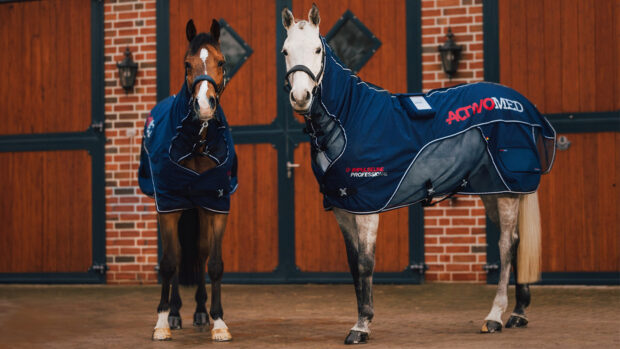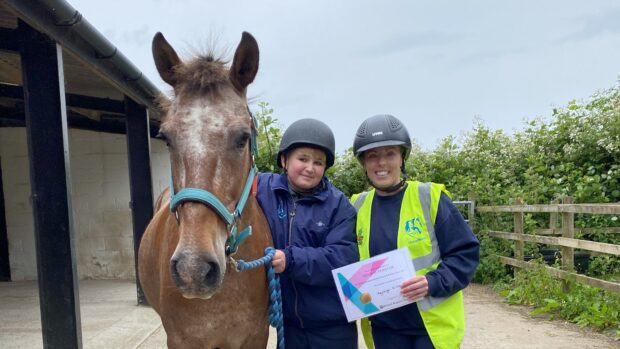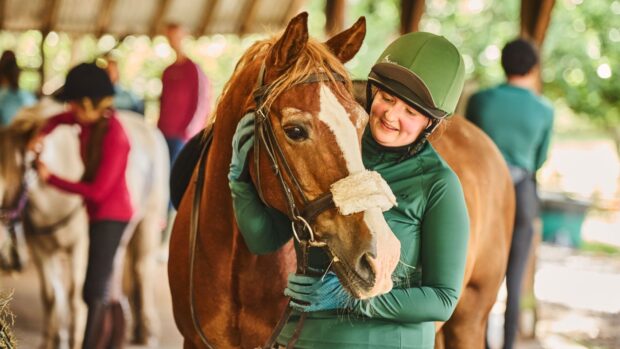Some of the most intensive and important exercise we undertake with horses referred to us is the work we do with them from the ground. It really is our bread and butter and may include either lunging or in-hand proprioceptive work, but most often will involve a period of long reining at some point.
We are particularly busy at the moment and as many of our horses are around the same stage in their rehab, the girls and I reckon we walk miles each day behind the horses between us!
I was asked to do a lecture demo for a group of second year degree students recently on the subject of long reining and it got me thinking about all the uses we find for it.
I have been long reining horses for years, having being taught how by my very first boss Jo Luton, so I could help start youngsters that came in to be backed. As soon as we had established ‘turn’ and ‘stop’ in the school, they went straight out along the lovely quiet lanes around my home in Scotland.
Jo reckoned that long reining helped establish their confidence and willingness to go forwards, as well as the beginnings of contact, straightness and cementing steering controls in place.
I still adhere to these basic principles, if not in a slightly adapted form — for a start we are missing the quiet back roads around Hartpury that we were so fortunate to have at home.
There are many reasons that we long rein horses rather than lunge them, the foremost of which is straightness; it’s amazing how many horses wiggle about when they have no help from a rider to, quite literally, keep them on the straight and narrow.
We also long rein them for accuracy and control. For example if the horse is restricted to straight lines and square turns only by the vet or therapist, then we may be able to achieve this more effectively in long reins than with a single line.
 Two line exercise also allows us to do lateral work with the horses, along with other movements such as rein back. We can switch them between true and counter bend, and improve the quality of their half-halts and transitions.
Two line exercise also allows us to do lateral work with the horses, along with other movements such as rein back. We can switch them between true and counter bend, and improve the quality of their half-halts and transitions.
A horse who is difficult or fussy in the contact can be helped by working them in long reins, and we often couple them with side reins to aid consistency in these type of cases.
In some respects, I think long reining beyond breaking in young horses has become a bit of a lost art. It seems that if there no specific reason to do it then people don’t even think about it as a way of working their horse, or indeed that they just don’t feel confident enough.
It’s a great skill to have and basically, if you have decent feel when you ride you will be pick up long reining no bother at all. We use light cord lines which run freely through the rings on the roller, and enable a more refined feel than with heavier material. Thicker lunge lines will do the job if that’s what you have available, but you have to remember that the further away you are from the horse, the more drag there will be on the mouth due to the weight of the line itself.
So my rule is basically that you should only be far enough away from the horse that you are well out of kicking distance!
We start all of our horses as if they have never had long reins on before to be safe, and I find that if something does spook them then it’s best if you go with them and bring them back to you as you go.
Standing stock still and pitching my weight against a 600kg horse has never really gone that well for me to be honest! You should always be on the move when long reining so it’s a bit of a work out.
End of the season
We’ve had a new wave of outpatients starting to use our services of late, largely those who were waiting until the end of their respective season or competition schedule to make a change to the horse’s routine.
Likewise we have a couple of horses who have been out with injury and are now coming back into work in preparation for the new year. Some of these are coming to us to use the Aquafit water treadmill and it’s always really nice to put more lovely horses on our books. They’ve all taken to it well so far and we look forward to getting them going over the winter — hopefully the owners will reap the benefits of their investment over the coming months.
A new addition
My horse Charlie is getting a new ‘little sister’ this week, as I await the imminent arrival of a four-year-old chocolate Labrador. Her name is Damson and she will be as involved as he is in proceedings around here as I’ve already primed our resident canine hydrotherapist, Tessa Lewis of Cotswold Dog Spa, to include her on her list of ‘demo dogs’. I’m told she loves water which is handy!
I have a feeling that will be a few Damson adventures to report in the coming weeks — watch this space…
Fizz





